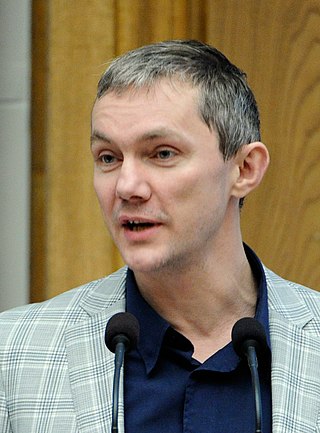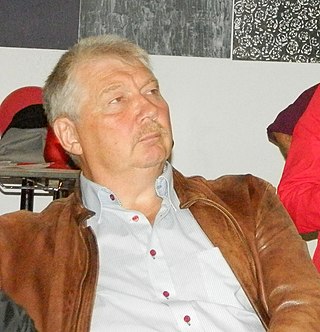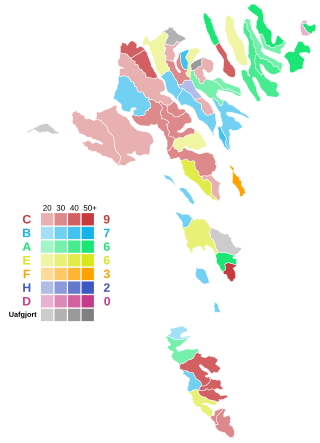
The early details of the history of the Faroe Islands are unclear. It is possible that Brendan, an Irish monk, sailed past the islands during his North Atlantic voyage in the 6th century. He saw an 'Island of Sheep' and a 'Paradise of Birds', which some say could be the Faroes with its dense bird population and sheep. This does suggest however that other sailors had got there before him, to bring the sheep. Norsemen settled the Faroe Islands in the 9th or 10th century. The islands were officially converted to Christianity around the year 1000, and became a part of the Kingdom of Norway in 1035. Norwegian rule on the islands continued until 1380, when the islands became part of the dual Denmark–Norway kingdom, under king Olaf II of Denmark.
The politics of the Faroe Islands, an autonomous country of the Kingdom of Denmark, function within the framework of a parliamentary, representative democratic dependency, whereby the Prime Minister of the Faroe Islands is the head of government, and of a multi-party system. The Faroe Islands are politically associated with the Kingdom of Denmark but have been self-governing since 1948. Executive power is exercised by the government. Legislative power is vested in both the government and the Løgting. The judiciary is independent of the executive and the legislature and the responsibility of Denmark.

The Løgting is the unicameral parliament of the Faroe Islands, an autonomous territory within the Danish Realm.
Sjálvstýri is a liberal, autonomist political party on the Faroe Islands. It is currently led by the Mayor of Klaksvík, Jógvan Skorheim.

Republic, formerly known as the Republican Party is a pro-independence left-wing political party in the Faroe Islands.

The Social Democratic Party is a social-democratic political party on the Faroe Islands, led by Aksel V. Johannesen.

The Faroese People's Party – Radical Self-Government is a pro-Faroese independence conservative and conservative-liberal political party on the Faroe Islands led by Beinir Johannesen. One of the four major parties, it has had eight seats in the Løgting since the 2019 election, making it the joint-largest party, but it has neither of the Faroes' seats in the Folketing.

The British occupation of the Faroe Islands during World War II, also known as Operation Valentine, was implemented immediately following the German invasion of Denmark and Norway. It was a small component of the roles of Nordic countries in World War II.
The Faroese language conflict is a phase in the history of the Faroe Islands in the first half of the 20th century. It was a political and cultural argument between advocates of Faroese and Danish to serve as the official language of the Faroe Islands.

The Danish Realm, officially the Kingdom of Denmark, is the area over which the monarch of Denmark is head of state. It consists of metropolitan Denmark—the kingdom's territory in continental Europe and sometimes called "Denmark proper" —and the realm's two autonomous regions: the Faroe Islands in North Atlantic and Greenland in North America. The relationship between the three parts of the Kingdom is also known as The unity of the Realm.
Same-sex marriage has been legal in the Faroe Islands since 1 July 2017. Legislation allowing same-sex marriage and adoption by same-sex couples was approved by the Løgting on 29 April 2016. The Danish Parliament approved the necessary legislative adaptations on 25 April 2017, and the law received royal assent on 3 May and went into effect on 1 July 2017.

The Faroe or Faeroe Islands, or simply the Faroes, are an archipelago in the North Atlantic Ocean and an autonomous territory of the Kingdom of Denmark. The official language of the country is Faroese, which is closely related to and partially mutually intelligible with Icelandic.
Early general elections were held in the Faroe Islands on 8 November 1946. The elections were called after King Christian X dissolved the Løgting following the contentious aftermath of the Faroese independence referendum held in September. The People's Party remained the largest party in the Løgting, winning 8 of the 20 seats. They were the last elections held before the Faroe Islands were granted home rule on 30 March 1948.
Early general elections were held in the Faroe Islands on 29 October 2011. Faroese law states that new elections must be held at least once every four years; however, either the Prime Minister (Løgmaður) or a majority of the members of the Faroese Parliament may call an election before the end of this period. The previous elections having been held on 20 January 2008, the latest date on which the next elections could have been held was 19 January 2012. However, the Prime Minister of the Faroe Islands, Kaj Leo Johannesen, announced on 27 September 2011 that elections would be held on 29 October 2011. He gave no particular reason for his decision.

Progress is a liberal, pro-Faroese independence political party on the Faroe Islands.

Sjúrður Skaale is a Faroese politician, journalist, skydiver, belly dancer, and comedian. He is a member of the Folketing for the Social Democratic Party. From 2008 to 2011 he was a member of the Løgting.
General elections were held in the Faroe Islands on 18 July 1906. The result was a victory for the Union Party, which won 12 of the 20 seats in the Løgting.

The Faroese independence movement, or the Faroese national movement, is a political movement which seeks the establishment of the Faroe Islands as a sovereign state outside of Denmark. Reasons for independence include the linguistic and cultural divide between Denmark and the Faroe Islands as well as their lack of proximity to one another; the Faroe Islands are about 990 km (620 mi) from Danish shores.

Kristin Michelsen is a Faroese politician (Self-Government).

Early general elections were held in the Faroe Islands on 8 December 2022. The opposition Social Democratic Party led by former Prime Minister Aksel V. Johannesen emerged as the largest party, receiving the largest vote share of any party since 1990, while Self-Government lost its Løgting representation for the first time since 1945.














